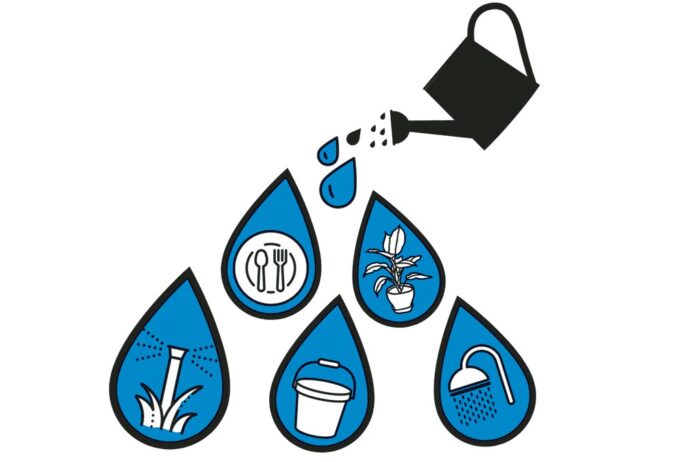Have you noticed that it’s been a little dry lately? While we’ve enjoyed the warmth and sunshine, it turns out that the Portland-Metro area just experienced its driest April on record – whoa!
In my household, we’re trying to pay closer attention to how we use water in our day-to-day activities. It is amazing to see (and feel – buckets can get heavy!) how much water actually ends up down the drain. Mostly, we’re watering plants with our “grey water,” which is the water draining from places like the sink and bathtub (as opposed to “black water” from toilets, which needs to be treated). Our own little water audit has proven to be quite motivating, and our plants are green and happy. Here are some things we’re doing, if you want to give them a try:
- Use that calendar:
Water your plants thoroughly but less frequently to encourage deep root growth and drought tolerance. My mother-in-law drew a color-coded map of her yard to keep track of which zones need watering on which days. - One less thing to remember: Add an automatic shut-off nozzle to your garden hose and you’ll save about 5-7 gallons for each minute it would have been running!
- Keep it a little more lush: A taller lawn provides shade to the roots and helps retain soil moisture, so your lawn requires less water.
- Give the soil time to absorb: If run off or puddling occurs, break longer watering sessions into several short sessions. This allows the water to soak into the soil between each session, resulting in a more thorough watering.
- Be an early bird or a night owl: Water early in the morning (before 10am) or later in the evening (after 6pm) when temperatures are cooler, and evaporation (water loss!) is minimized. Don’t forget to adjust sprinklers so that they’re watering the green and not the concrete.
- Leaks! One drip every second adds up to five gallons per day! Check around your home, both inside and outside. For example, put food coloring in your toilet tank. If it seeps into the bowl without flushing, you’ve got a leak.
- Collect and pour:
While you wait for hot water in the shower or bath, collect the running water in a bucket and use it to water plants. Also, take shorter showers. - Use a bowl – Part 1:
Keep a medium bowl in or near your sink. When you rinse your hands, dishes, or fruits and vegetables, rinse over the bowl. Then pour that water on plants. Sure, you’ll make lots of trips back and forth, but it certainly counts as exercise (cardio and weights?!). - Use a bowl – Part 2:
Hand wash dishes in a bowl of soapy water, only running the tap to rinse. You can save about 2.5 gallons of water for every minute your faucet doesn’t run. Or go big and use a rinse bowl, too. - Two birds, one sprinkler: When the kids want to cool off, set a timer and use the sprinkler in an area where your lawn needs it most.
- Ice cubes: When ice cubes are leftover from your drink (or are dropped on the floor), don’t throw them out. Dump them on a plant (you can also do this with that glass of water that goes stale on your nightstand every night).
- WaterSense is good sense: Look for this label on showerheads, faucets, faucet accessories like aerators, and toilets to help identify models that save water and perform well. An aerator, for instance, reduces the flow from the faucet and uses air to maintain good water pressure, which can save 1 gallon per minute.
- Use an electric teakettle: This way, you don’t have to run the tap waiting for the water to heat up (plus, kettles let you set the ideal water temperature for different types of tea. Steep accordingly!)
- Keep it in the fridge:
If you find yourself running the tap to get it to the perfect, icy-cold temperature, consider keeping a pitcher of water in the fridge so there’s always cold water on hand and you won’t need to run the tap! - Bigger picture:
Our diets account for roughly half of all the water we use. While all food has a water footprint, eating fewer animal products and more plant-based foods can shrink your water footprint significantly. Consumer products are an often-overlooked source of water use. Buying less of everything or purchasing secondhand—from clothing to electronics to household goods—can also dramatically decrease your water footprint (and increase your wallet)!
Being aware of water consumption is good for everyone – our water suppliers, our farmers, our neighbors, our local plants and animals, and our wallets – especially heading into Oregon’s dry season.
For more information, please visit:
- Regional Water Providers Consortium – www.regionalh2o.org
- Tualatin Soil and Water Conservation District – tualatinswcd.org
- Tualatin River Keepers – tualatinriverkeepers.org


















